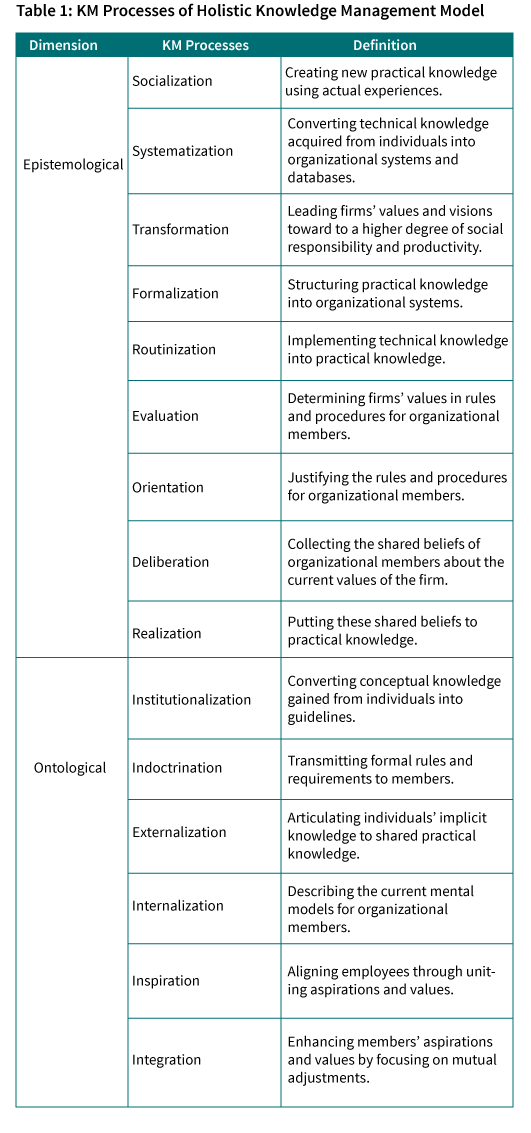Insufficient consideration of the completeness of knowledge management models has been exposed and the author attempts to address this concern for the first time. This article investigates the crossover potential of scholarly research and how it can be applied in the organizational boardroom.
Strategic Management and the Knowledge-based View
Although the knowledge-based view emerged in the field of strategy, its origins and foundations stem from the resource-based view of the firm. The resource-based view highlights the role of organizational resources in achieving a higher degree of competitiveness. When executives embrace the resource-based view, organizational resources are crucial for competitiveness if they are valuable, rare, inimitable and non-substitutable. However, internal resources of companies manifest themselves in tangible (such as physical properties and machinery) and intangible (such as intellectual capital) forms. Intangible resources, in form of intellectual capital, exist primarily as knowledge in human resources and cannot be easily imitated. This, by far, is why some organizations are successful and some are not. The reason for success and failure of organizations, based on this resource-based view is that there are two capabilities – causal ambiguity and social complexity. Operational risk of large organizations is at risk if they can be easily imitated by the competition. Therefore, decreasing the imitability of an organization’s products or services also decreases the operational risk. While causal ambiguity refers to multiple interpretations of knowledge, social complexity has been regarded as “the extent to which resources are embedded in multiple organizational members and the relationships among them”.1 Thus, harder to copy or imitate.
Executives know that discontinuity exists at all levels of product and services and they do not want to find themselves caught off guard and become obsolete. To remain competitive, executives realise that they have to quickly create and share new ideas and knowledge to be more responsive to market changes. Organizations are “social communities that specialise in the creation and internal transfer of knowledge”.2 Importantly, knowledge held by organizational members is the most strategic resource for competitive advantage, and also through the way it is managed by executives.
Knowledge Management Models May Shed Light on Executive Success
Executives need to at least take a look at models associated with knowledge management, which is directed at developing a better understanding of the concept of knowledge management within organizations.
Knowledge Creation Model
Hirotaka Takeuchi and Ikujiro Nonaka argue that tacit and explicit knowledge interact through four processes, including socialisation (i.e. tacit to tacit), externalisation (i.e. tacit to explicit), combination (i.e. explicit to explicit), and internalisation (i.e. explicit to tacit).3 Executives can use socialisation which is associated with coaching and mentoring activities by sharing experiences gained by imitating, observing and practicing. In the externalisation process, tacit knowledge is articulated into formal language that represents official statements, and is equivalent to explicit knowledge. Executives have their internet technology departments to create a combination which reshapes existing explicit knowledge to more systematic and complex forms by, for example, using internal databases. Most importantly, in internalisation, explicit knowledge is internalised through “learning by doing” which is more engaging. Figure 1 illustrates how knowledge can be converted to create new knowledge that executives can view and implement immediately in managerial decision making.
While executives can use this model for knowledge management, they must be aware of some criticism from other scholars. For example, René Jorna criticizes Nonaka and Takeuchi’s model, because of its failure to account for the commitment of various groups that may have special knowledge from competitors or different types of organizations.4 In addition, Baiyin Yang, Wei Zheng and Chris Viere believe that there might be differences in how to manage individual knowledge from managing knowledge at the organizational level, and they observe that this model has also failed to pay attention to this matter.5 Barring the criticisms, this model can immediately be applied to large organizations and executives can have someone on their team implement it accordingly.
Executives can use Learning with Knowledge Cycle Model
Another easy model for executives to use is Rowley’s knowledge management model. This model includes knowledge creation and construction, knowledge articulation, knowledge repository updating, knowledge access, knowledge use, and knowledge revision. Jennifer Rowley says learning in organizations is the ultimate outcome of the knowledge cycle by which implicit knowledge is created and acquired by connecting knowledge with other companies that want to share successes and failures.6 This leads to converting acquired knowledge into organizational processes and activities to improve or discontinue processes that either contribute or inhibit success.
There are other scholars that feel that “meaningful learning in social contexts requires both participation and reification to be in interplay,” and highlight the strategic role of communities of practice in enhancing a shared understanding among members.7
Etienne Wenger also sees communities of practice as social “containers” of competences, and defines them as “groups of people who share a concern or a passion for something they do and learn how to do it better as they interact regularly”.8 Executives can help followers add meaningfulness to their work in ways utilizing social contexts or social containers to enhance engagement.
Implicit knowledge is incorporated into formal language and subsequently becomes available to be shared within organizations. Moreover, organizing explicit knowledge using databases and archives can make knowledge available throughout the organization – organized knowledge can be disseminated and searched by others.
As executive trainers, I agree with Jennifer Rowley who suggests training courses as an effective way to share explicit knowledge. Most importantly, applying knowledge aimed at providing better decision-making and work related practices and creating new knowledge through innovation. Knowledge has to be measured in some way, many trainers talk about return-on-investment of training which is hard to measure, training satisfaction measurement by participants and their desire to apply it to the workplace is a an excellent barometer of learning new skills or building upon old ones. Once knowledge is accumulated, the current processes may be supplemented or even substituted. Figure 2 depicts this knowledge cycle based on Rowley’s model. The key point in the model is the knowledge use section coupled with testing and re-testing to ensure that the knowledge is actually helping the organization grow both professionally for individuals and profitably for all stakeholders.
Executives must be aware of some of the limitations of Rowley’s (2001) model. For example, Baiyin Yang, Wei Zheng and Chris Viere argue that this model is not concerned about how knowledge moves from one stage to another, and only described the activities related to each stage separately.5 Secondly, the model does not visualise the potential interactions between implicit and explicit knowledge, and fails to account for the critical role of dynamic interrelationships among followers and business units in enhancing learning processes within large organizations. The model is challenged in that the processes of use, measurement, and revision for implicit knowledge, if not impossible, are very hard. Although Rowley’s model strongly contributes to the conceptualisation of knowledge conversion from the individual level to the organizational level, this model itself suffers from several limitations. While the limitations of the model may only be at the surface level, executives may miss opportunities to fully develop knowledge management systems based upon these weaknesses. On the other hand, Baiyin Yang, Wei Zheng and Chris Viere extensively propose a holistic knowledge management model that may be more appropriate to encompass more aspects of knowledge management.
Holistic Knowledge Management Model
As executives attempt to apply the holistic knowledge management model, they incorporate perceptual (i.e. implicit), conceptual (i.e. explicit), and affective (i.e. sentiment and emotion).5 These scholars argue that their model is more appropriate for executive use because knowledge could be managed in the three epistemological areas; technical, practical, and critical, and also in six ontological dimensions; institutionalisation, indoctrination, externalisation, internalisation, inspiration, and integration. These scholars posit that the levels of knowledge are enhanced – especially at the technical level. This is strongly relevant to conceptual knowledge that is found to be at the higher echelons of large organizations. Furthermore, activities that executives perform relate to managing formal procedures and rules. The practical level can be associated with perceptual knowledge such as social norms and shared experiences which can add to cultural norms. Affective knowledge, which is reflected in moral and ethical standards and the degree of awareness about organizational visions and missions can in-turn be used in strategic decision making. Another important aspect of this model for executives is Ann Tenbrunsel, Kristina Diekmann, Kimberly Wade-Benzoni and Max Bazerman’s view.9 These scholars look at moral emotions in neuroscience that are manifested in a trichotomy of prediction, action, and recollection. This aspect can further develop executive decision making because there is significance evidence of an influence upon various cognitive functions such as problem-solving.
Executives are faced with challenging economic conditions today with global competition increasing and the need to be number one or two in an industry or fail to keep up with the market place. This new economic environment may have a negative emotionality that can seriously reduce people’s capabilities in changing and overcoming challenging situations.10 The trichotomy is described further with Ann Tenbrunsel, Kristina Diekmann, Kimberly Wade-Benzoni and Max Bazerman who posit that “people predict that they will behave more ethically than they actually do, and when evaluating past unethical behavior, they believe they behaved more ethically than they actually did”.9 Ergo, the ruination of corporate giants such as Enron and WorldCom just to name a few fiascos.
To offset the negativity associated with widening the gaps of success and failure, Baiyin Yang, Wei Zheng and Chris Viere propose nine knowledge management processes in the epistemological dimension, including socialisation (i.e. implicit to implicit ), systematisation (i.e. explicit to explicit), transformation (i.e. affectual to affectual), formalisation (i.e. implicit to explicit), routinisation (i.e. explicit to implicit), evaluation (i.e. affectual to explicit), orientation (i.e. explicit to affectual), deliberation (i.e. implicit to affectual), and realisation (i.e. affectual to implicit).5 This may be the answer executives need but may also lack the fundamental fortitude necessary to be an all-encompassing model to predict customer satisfaction, employee or follower satisfaction, and financial profitability. Figure 3 portrays these processes within organizations:
Executives can review the nine knowledge management processes in the three epistemological areas of technical, practical, and critical knowledge are described in the following table.
In Conclusion
Executives embrace the holistic knowledge management model because it takes a task-based approach by translating the management of knowledge into a complete set of processes. In fact, the holistic knowledge management model develops an integrated approach by which organizational knowledge provides a significant contribution to financial objectives through the context-dependent way it is managed.
About the Author
 Mostafa Sayyadi, CAHRI, AFAIM, CPMgr, works with senior business leaders to effectively develop innovation in companies, and helps companies – from start-ups to the Fortune 100 – succeed by improving the effectiveness of their leaders. He is a business book author and a long-time contributor to HR.com and Consulting Magazine and his work has been featured in these top-flight business publications.
Mostafa Sayyadi, CAHRI, AFAIM, CPMgr, works with senior business leaders to effectively develop innovation in companies, and helps companies – from start-ups to the Fortune 100 – succeed by improving the effectiveness of their leaders. He is a business book author and a long-time contributor to HR.com and Consulting Magazine and his work has been featured in these top-flight business publications.
References
1. Reus, T.H. (2004). A knowledge-based view of international acquisition performance (Doctoral Dissertation). The Florida State University, USA.
2. Kogut, B., & Zander, U. (1993). Knowledge of the firm and the evolutionary theory of the multinational corporation. Journal of International Business Studies, 24(4), 625-645.
3. Nonaka, I., & Takeuchi, H. (1995). The knowledge-creating company: how Japanese companies create the dynamics of innovation, New York: Oxford University Press.
4. Jorna, R. (1998). Managing knowledge. Semiotic Review of Books. Faculty of Arts & Science, University of Toronto.
5. Yang, B., Zheng, W., & Viere, C. (2009). Holistic Views of Knowledge Management Models. Advances in Developing Human Resources, 11(3), 273-289.
6. Rowley, J. (2001). Knowledge management in pursuit of learning: the learning with knowledge cycle. Journal of Information Science, 27(4), 227-237.
7. Wenger, E.C. (2010). Communities of practice and social learning systems: the career of a concept. In C. Blackmore (Eds.), Social Learning Systems and communities of practice. Berlin: Springer Verlag.
8. Wenger, E.C. (2009). Communities of practice a brief introduction. The University of Sydney.
9. Tenbrunsel, A.E., Diekmann, K.A., Wade-Benzoni, K.A., Bazerman, M.H. (2009). The Ethical Mirage: A Temporal Explanation as to Why We Aren’t as Ethical as We Think We Are. Harvard University.
10. Okon-Singer, H., Hendler,T., Pessoa, L., Shackman, A. (2015). The neurobiology of emotion–cognition interactions: fundamental questions and strategies for future research, Frontiers in Human Neuroscience, 9, 1-14.







































































